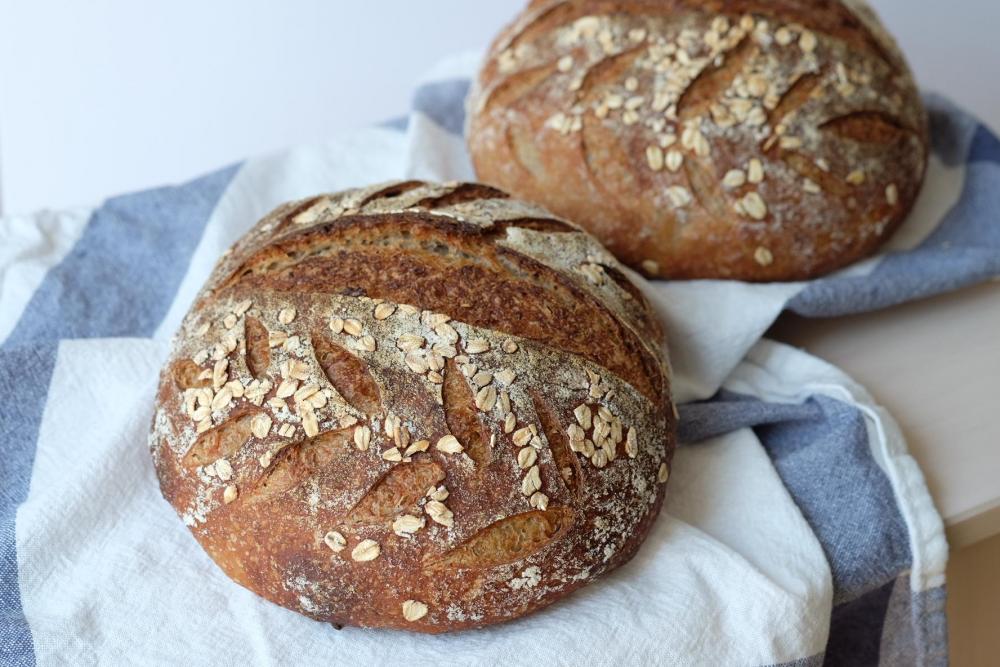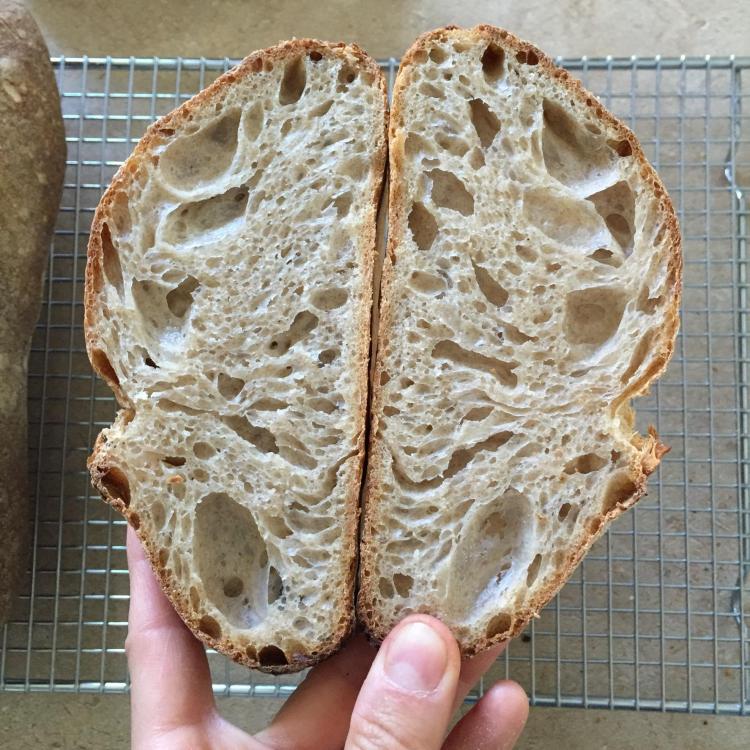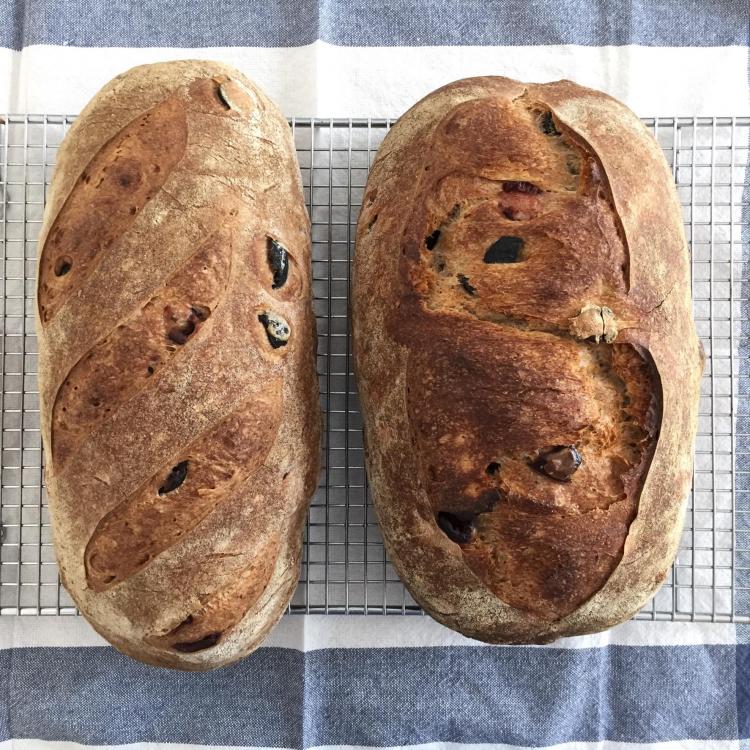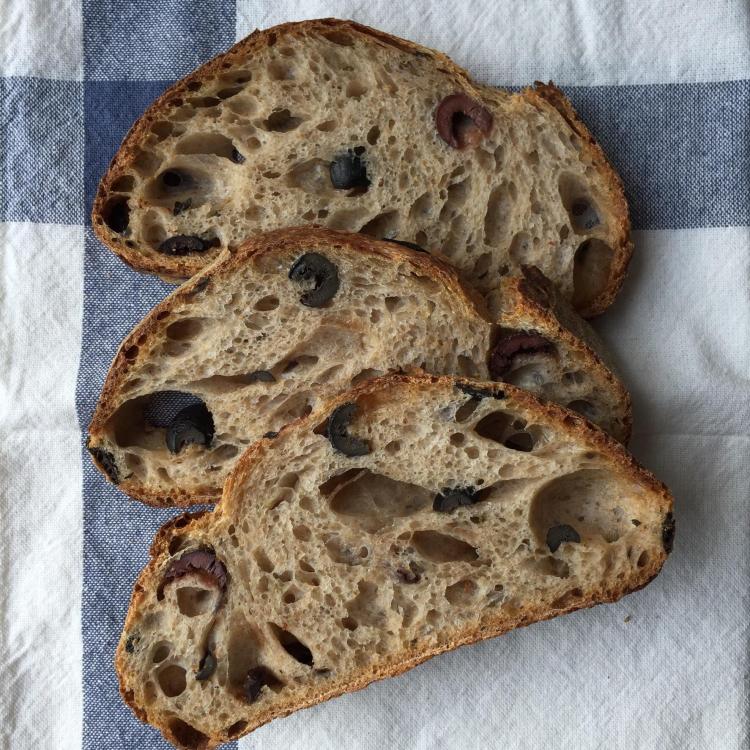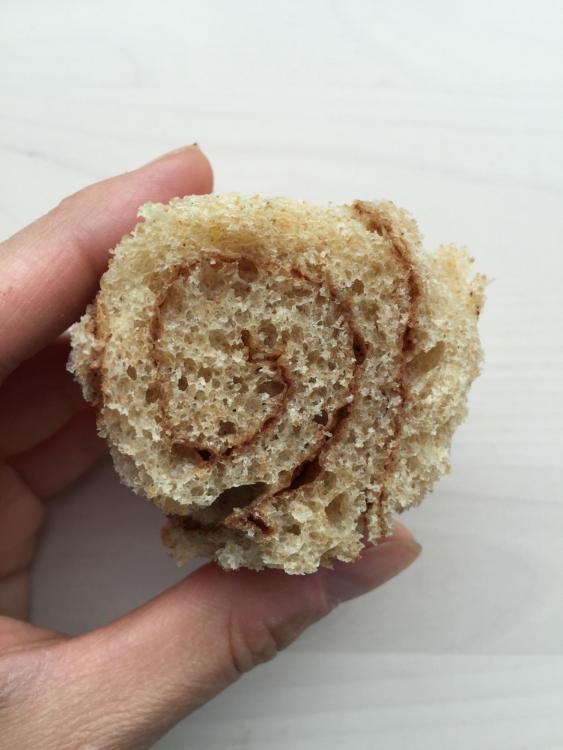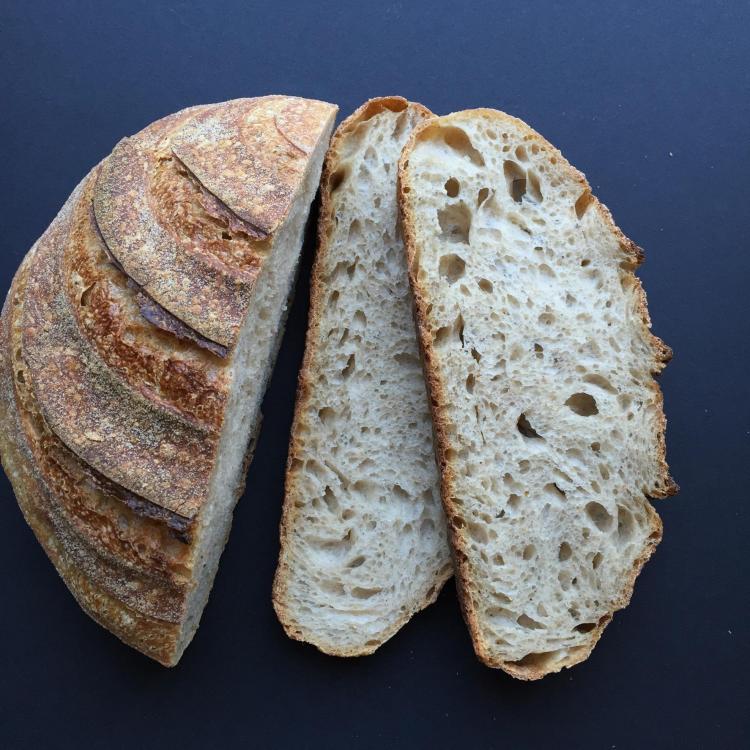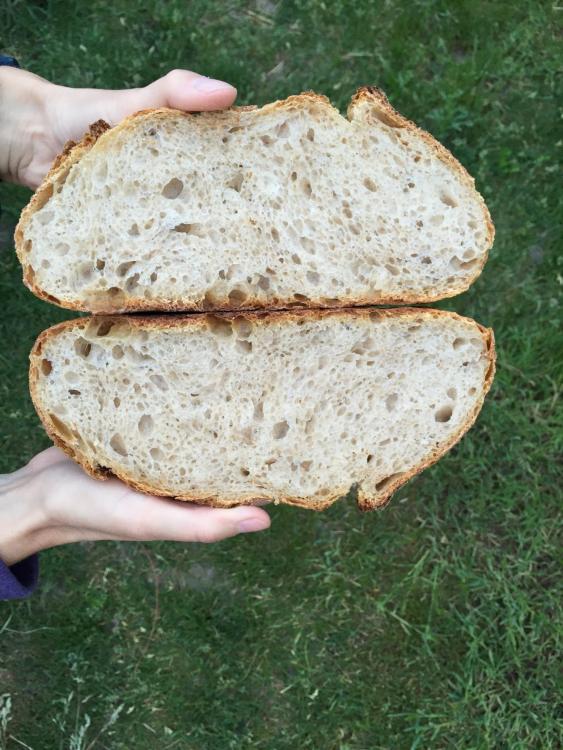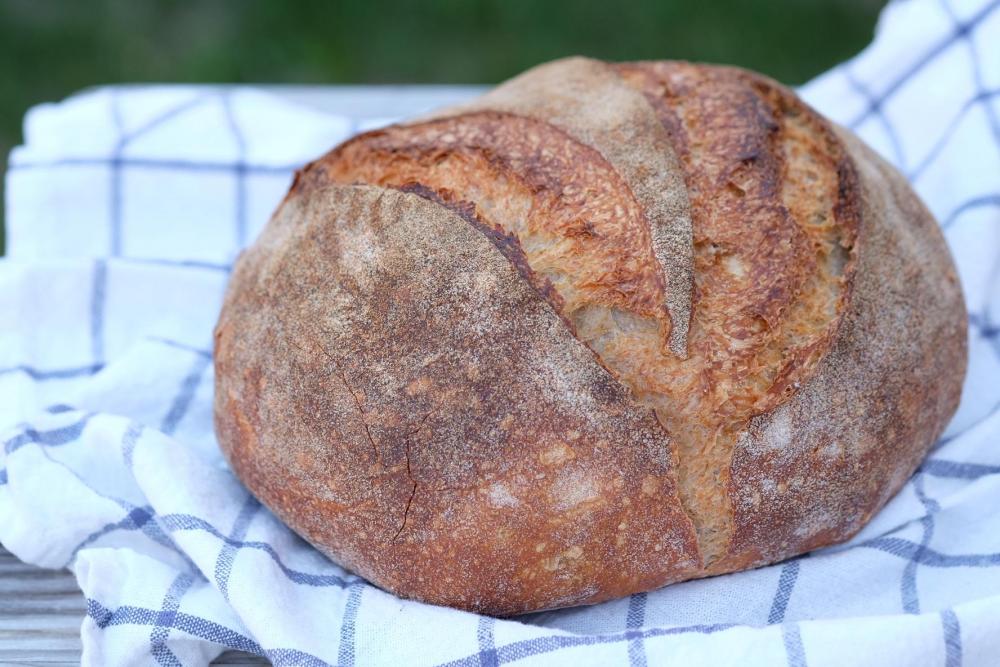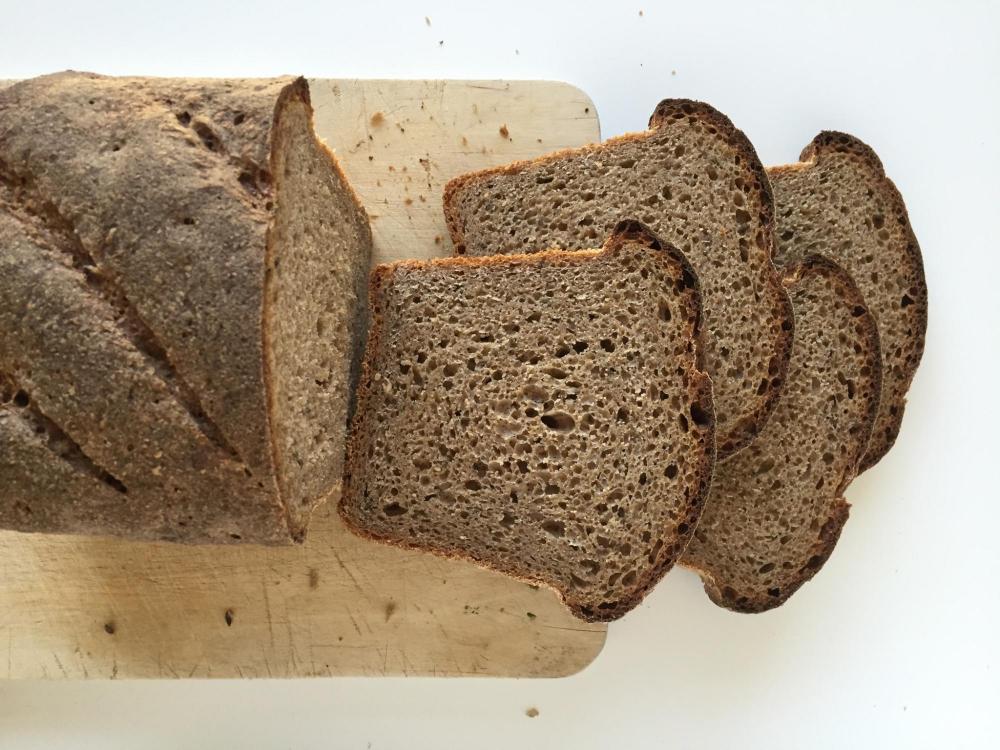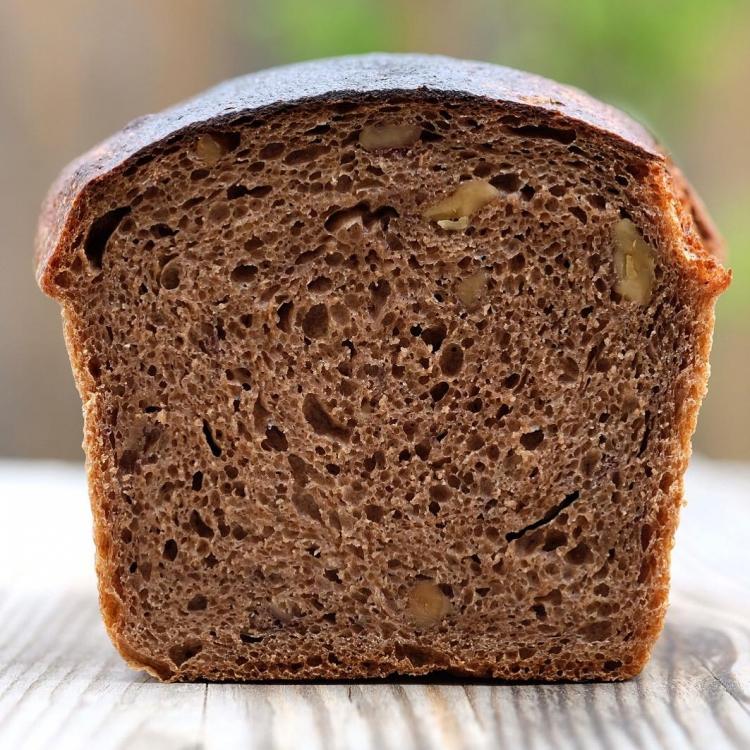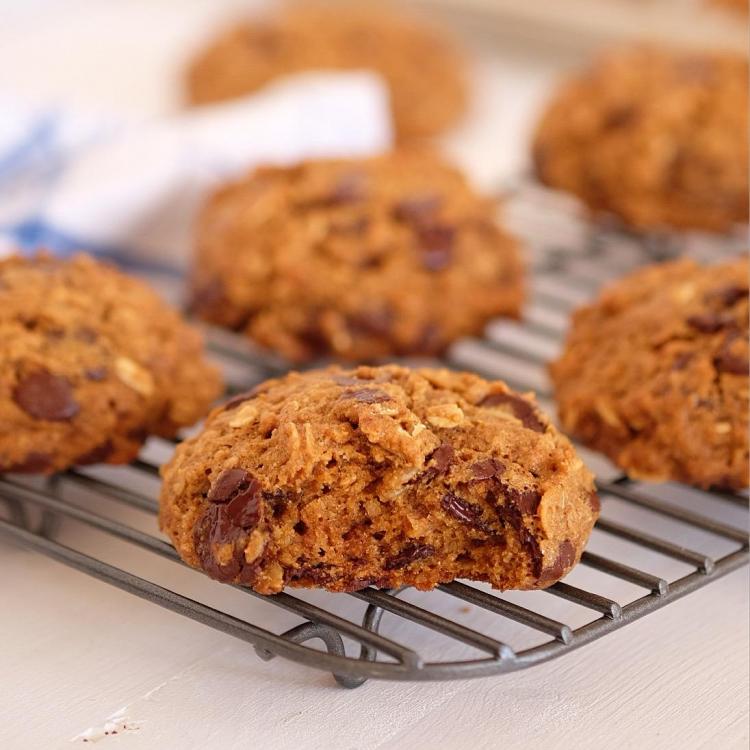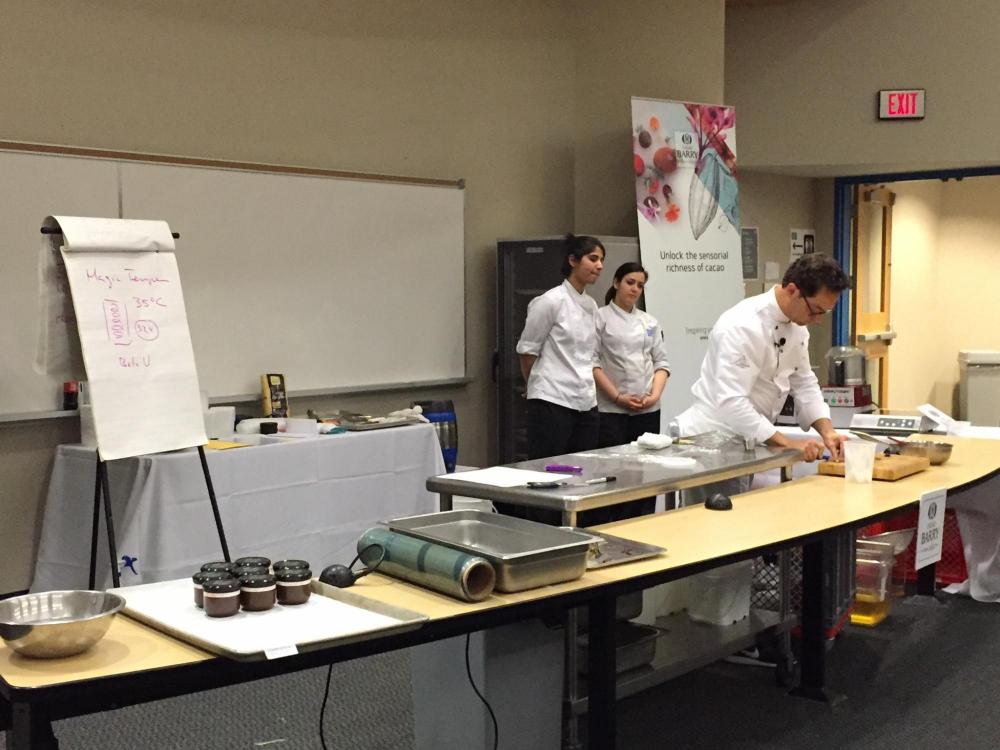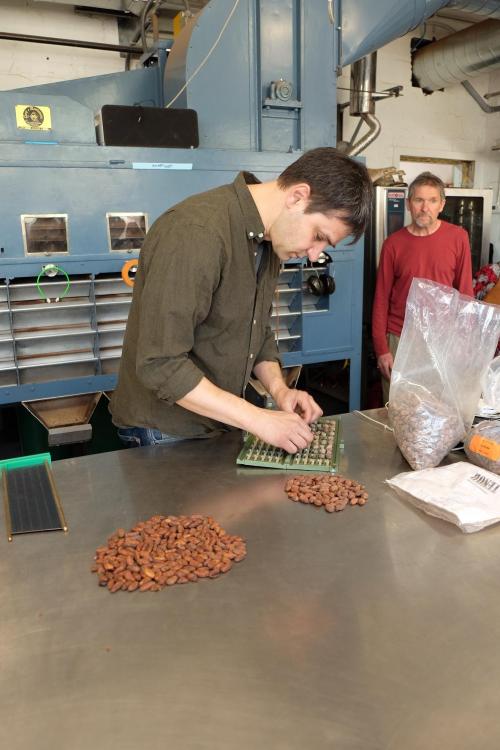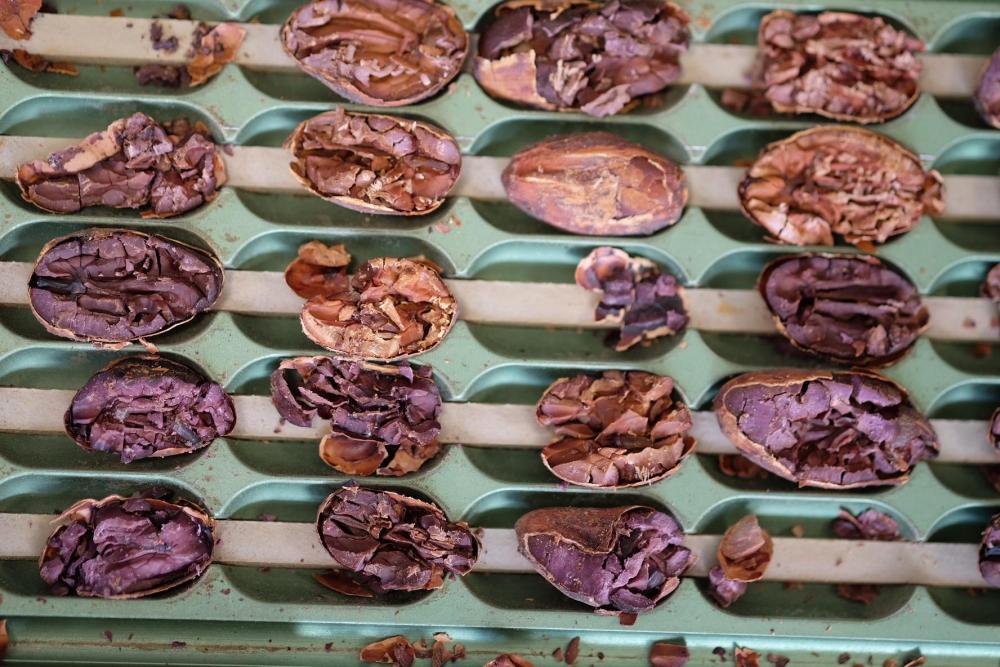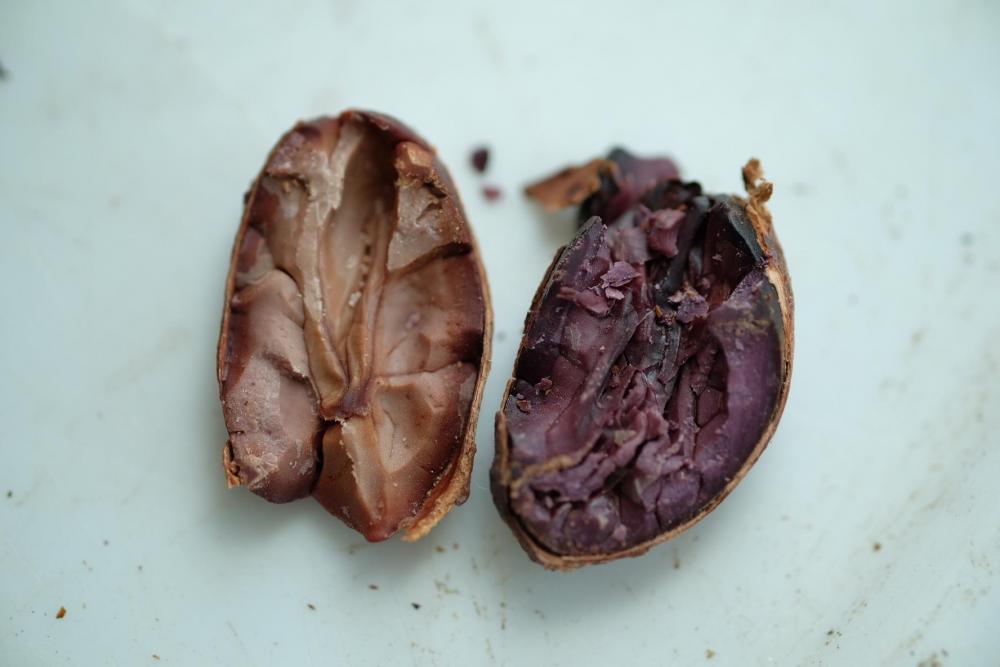-
Posts
300 -
Joined
-
Last visited
Content Type
Profiles
Forums
Store
Help Articles
Everything posted by DianaM
-
@Kerry Beal Kerry, where could I find a pullman pan that does not cost a fortune? I looked at amazon, they sell USA Pan pullmans in two sizes, but dang! They cost their weight in gold. It would not see very much use, but I'd like to try one for a high-percent rye loaf. Diana
-
I've bookmarked a few of Sarah Owens's recipes from her book, and this is the first bread that I made, honeyed oat and spelt levain. It contains a good amount of large flake oats, and some wholegrain spelt flour, and this makes for a tighter crumb. The honey is just enough to offset the light sour and give another subtle flavour dimension the crust. If I hated sourdough, I feel this loaf would change my mind.
-

Your Daily Sweets: What Are You Making and Baking? (2015 – 2016)
DianaM replied to a topic in Pastry & Baking
Thank you, @cakewalk. Yes, that plunger got very light action, otherwise we too got dismembered animals. The flour is a mix; the bulk of it is large flake oats and raw buckwheat groats pulverized in the blender and mixed with almond meal, and there is also arrowroot starch to lighten things a bit. Recipe here. -
Host's note: this is part of a large topic that has been split into smaller segments to reduce the load on our servers. The previous segment may be found here: The Bread Topic (2015-2016). I've been trying to settle on a formula for a nice, basic, no frills sourdough which my friends (with zero interest in whole grains) can enjoy, and I think I've found my winner in a country white (10% w/g spelt) with 80% hydration. Mild, mild sourness despite the 12 hour cold proof. I want to try holding back some of the water to see if I can achieve better loft, but otherwise, I am happy with the formula.
-
How is the starter doing, @paulraphael? Sorry about my delay in responding, I hope my answer will still prove useful. I have Reinhart's book, and I love it for yeasted stuff, but for sourdough, I myself look elsewhere. How do you like your cookbooks? Dependable? Technical? Full of pictures? Modern? -clear and detailed information, dependable formulas and a quiet but contagious love for the craft of breadmaking - J. Hamelman's Bread. If I have a question about sourdough, it's the first reference I check. JH is the Bakery Director at King Arthur Flour, if I'm not mistaken. There are very useful step-by-step drawings, but don't expect many pictures, and you gotta love arithmetic because every formula is given in oz/g for a production environment (10 loaves etc), and only in cups for 1-2 loaves. I can PM you a pic of a formula if my description is not clear. It is technical, yes, however I would not call the book "modern." -if you love whole grains check out Tartine nr. 3, by Chad Robertson of the famous Tartine bakery in SF. Definitely modern, the book looks beautiful to me, with its full-page images of incredible crumb shots, but the doughs are so very wet, and I feel my skills level is inadequate at this point (unless I change the formula by holding back some of the water). I love the idea of porridge bread, I just have not been able to successfully make one yet. Bonus points for the wholegrain pastry chapter, it's something valuable to me. -I've received in the mail just days ago Sarah Owens's Sourdough. She has won a James Beard award for it. Rustic breads, and other baked goods made with leftover starter (madeleines, pies, savoury tarts, sablés, a bundt, couple cakes etc). Very interesting formulas, there's a nettle and ale bread, smoky chili bread, a turmeric and leek levain, blue corn pain épi. Beautifully photographed. Whole grains. Botanical Latin in the recipe notes. What's not to love?!? Lol. Online: -the blogs: http://www.wildyeastblog.com and https://www.theperfectloaf.com -I think @keychris has mentioned http://www.thefreshloaf.com -youtube for shaping videos (I believe Cyril Hitz has a couple up there and the SFBI) -instagram if you want to stare at bread pics - I admit I do Host's note: this topic has been split into multiple segments to reduce the load on our servers. To see the next delicious installment, click here.
-

Your Daily Sweets: What Are You Making and Baking? (2015 – 2016)
DianaM replied to a topic in Pastry & Baking
Animal crackers for son. I love the challenge of baking *-free, so these are gluten-free, vegan, and made with unrefined sugars. Son didn't seem to mind.- 486 replies
-
- 21
-

-
Olive levain from J. Hamelman's book, with some changes. Built yesterday, cold proofed, then baked today. I used a mix of Kalamata, salt-cured and regular black olives, and also added lemon zest and herbes de Provence. @DianaB I, too, stuggle with scoring. I scored the two loaves differently and learned what a dramatic effect it has on the final shape. These two are the same dough, same quantity (I weighed each), treated in the exact same way apart from scoring. The slices are from the loaf on the right. It must be my lucky day, I don't usually get a crumb like that.
- 492 replies
-
- 14
-

-
Thank you, @shain for your comment. I made some cinnamon rolls and, of course, more bread. The rolls are made entirely of spelt, I had some light spelt at the bottom of a bag nearing the best before date, and added some wholegrain spelt too. I subbed coconut oil for the butter, and coconut milk (from a carton) for regular (son's eczema is aggravated by dairy). It worked really well, fermentation went really fast, so either yeast looooves coconut, or the wholegrain spelt gave it a boost. Either way, bulk was 1 hour, and proofing took half hour. Oh, and added some chai spice into the cinnamon mix, thought it'd work well with all the coconut. Not an easy dough to work with, they looked a bit ragged going in the oven, but it all worked out. They were so light in the hand, lotsa yummy air in those alveoli. And again the pain au levain with whole wheat, it's my husband preferred bread, so I wanted to be nice and made it for him.
- 492 replies
-
- 12
-

-
What is the hydration of your starter currently? And how long will you be gone? You can make a stiffer starter (dial down the hydration little by little if you keep it 100%) and after the last feed before you go, leave it out on the counter a little while to get it fermenting. Then you refrigerate it. Mine was ok after three weeks in the fridge like this. Because I love my starter very, very much I also made a "back-up copy" for the freezer. I dried it like in the link above, and then put it in a sealed bag in the freezer. I left it there for a year, and it was still viable after all that time.
- 7 replies
-
- Bread
- Troubleshooting
-
(and 1 more)
Tagged with:
-
I've baked two batches of bread this past week, one was the pain au levain with whole wheat flour from Jeffrey Hamelman's "Bread," and the other a 66% rye sourdough pan loaf with caraway seeds. I loved both, for different reasons. The pain au levain could have used a bit more proofing, I think, judging by the look of the crumb. As for the rye, I was very happy with how it turned out, except that the dough was a bit too much for the pan. You can see how it "muffin-topped" instead of remaining below the rim of the pan to get a nice, neat loaf. I expected it to be much denser, but I am glad I was wrong. What I love most about it is its keeping qualities: it was 2 days old today and if anything, it was better than the day before. Had it with tapenade and soft-boiled egg for lunch and it was so good!
- 492 replies
-
- 15
-

-
Thank you, Franci! It was a very entertaining experience, although at the time it didn't seem so. To be honest, I expected the worst when the gas ran out (like gooey, raw bread) and I was pleasantly surprised by the crumb when I cut into it.
-
I call this one Scorch Trials. It is a 100% wholegrain spelt sourdough pan loaf with walnuts (recipe from Josey Baker Bread). I mixed the leaven on Friday evening, and Saturday morning, when I needed to toast the walnuts, the oven would not start. Toasted the nuts on the bbq, and decided if the oven continued to misbehave, I'd bake the bread on the grill too. All attempts to resurrect the oven failed, so I preheated the grill and lay the bread inside with some trepidation. About 30-35 mins into the bake, the gas in the propane tank of the bbq ran out, and I watched as the temp indicator started its slow descent towards zero. A few choice words were uttered. So I started the broiler (oddly, the broiler function of the oven was still working), and basically pre-heated the oven with it. I put the bread on the lowest rack, broiler on low, but after about 10 mins, the top was so scorched that I decided to end this crazy-a** experiment, whether the bread was baked through or not. It is a delicious loaf, the crumb is spongy and tender, with just a bit of sour when you first bite into it. I love whole grains! Spelt (wholegrain) makes such an interesting dough to work with, stretchy and obedient. I will be making this one again.
- 492 replies
-
- 14
-

-
Would scraping cocoa butter off the mold not damage it? Just this morning the same thought occured to me, as what Chocolatspassion describes. Cut verrrry thin strips of adhesive, stick them in the mould, spray with black. Remove, spray with copper. Then shell as normal. From a production standpoint this is a nightmare of course, but maybe for a limited edition bonbon?
-
@Anna N If Fortino's ever runs out of semolina rimacinata, there is an Italian bakery called La Rose here in Milton and they have it. This is just a sourdough boule I made, a whole lot whiter than usual, but the flavour was very good. I feed my starter often, so there is no buildup of acetic acid, and the sour flavour is not too pronounced - that's exactly how I like it. The dough was a bit more hydrated than I am used to, so shaping was difficult, just another thing to practice, practice, practice.
- 492 replies
-
- 13
-

-

Your Daily Sweets: What Are You Making and Baking? (2015 – 2016)
DianaM replied to a topic in Pastry & Baking
-
I don't know if this might be helpful to you or not, but here goes. Sugar substitutes like aspartame and sucralose (Splenda) have a bad reputation, and I don't have the knowledge to judge if the research condemning them is sound or not, so I just avoid them. Aspartame is banned in the EU as far as I know. When I tried to reduce the sugar in mine and my family's diet, I looked at natural sweeteners with a lower glycaemic load, and which also contribute some (if minimal) nutrients (trace minerals which have not been removed by refining). I have not baked with white/brown sugar in a very, very long time. I have had very good success replacing white or brown sugar in recipes with coconut sugar. It has a much lower glycaemic load than sugar; it makes the product much less sweeter, and personally I love that - and it's incredible in chocolaty baked goods. It has a caramel/butterscotch flavour which I love, and you can replace sugar with it cup for cup. Its flavour does not work well with everything though. Maple sugar and sucanat also work well, just reduce the sugar called for in the recipe by half (I'd use 1/2 cup sucanat for every cup of sugar the recipe calls for). My favourite sweeteners are liquid sweeteners, I am very partial to maple syrup. There's also agave, brown rice syrup (it's stickiness works wonders in granola bar or nut bar recipes), and coconut nectar. But you have to reduce the liquids in the recipe, and since this can be tricky, I look for recipes specifically made for these sweeteners - there are tons! The beauty is that these liquid sweeteners are mostly interchangeable amongst themselves, so if you only buy one, you can use it in recipes calling for any of the others. To me, the flavour of stevia is downright vile. I wanted badly to love it but no dice. It has a very bad aftertaste. Then, there is xylitol, but as with all sugar sugar alcohol, there is the trouser trumpet factor to be considered. If you have any questions or are looking for recipes, I'd be happy to help. Diana
-
Here we go. I am adding only one pic from the Moratò demo, since RobertM has pretty much covered it. The rest of the pics are from our visit today at Soma. The first one is of David, explaining how cacao beans get from farmers in cacao-growing countries to chocolate makers like himself. The roasting machine is a very old one, but judging from the taste of the chocolate we sampled, it still does an excellent job. Before they go into the roaster, however, every batch of beans are visually checked for quality with the use of the guillotine - David is placing a random sample of a batch into it. We were quite surprised to see such a variation in the colour of the beans within a single batch (they were all coming from the same country, and were meant for the origin chocolates Soma makes). You can see it even better in the close-up. We then went on to see the grinder, the conch, and all the other machinery which help transform the beans into chocolate. The visit concluded with a sampling of three kinds of chocolate: a 70% from Venezuela, a 62% blend of beans from Dominica and Equator, and a milk gianduja. All three were exquisite, imho. One thing that the pictures cannot convey is the intoxicating scent that hit us as soon as we stepped into the lab, it was quite memorable for me. I am so grateful to have been there to experience it. DianaM
-
I took some pics, and some brief notes too at the Moratò demo. I will post the pics later today or tonight, and if someone is interested in the notes, I can post those too. Off to have some breakfast before heading to Soma. DianaM
-
Kerry, I too have a couple of questions. Morato demo: do we meet someplace in the building to go in as a group, or do we sit wherever? Parking at Soma and Goûter: status? Available? Free? Paid? Not a chance? Etc. Thank you.
-
Kerry, I have just bought my ticket for the Morato demo. I may or may not get there by 4pm sharp, but I'll do my best. See you all there! Diana
-
I do have some extra molds, and an (unused) 6 kg Mol d'Art. @Tri2Cook I will PM you most likely on Monday, if that's ok. Will bring along to the workshops as well, in case anyone is interested. Diana
-

Your Daily Sweets: What Are You Making and Baking? (2015 – 2016)
DianaM replied to a topic in Pastry & Baking
- 486 replies
-
- 25
-

-
Hi Kerry, I am in for the Soma visit also. Thank you.
-
Thank you for being patient with me, Kerry. Please put me down as a definite for the Friday visit to Soma, as well as the Saturday and Sunday learning sessions. (Sadly) no for Morato, Friday show and tell, Saturday dinner. Diana
-
Kerry, Is the offer for the IR thermometers for $20 still valid? If so, I'd like one as well. Thank you!


